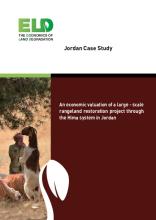/ library resources
Showing items 1 through 8 of 8.Jordanian rangelands are a source of valued livestock produce, carbon storage, biodiversity, and medicinal plants. They also serve as watersheds that receive rainfall, yield surface water, and replenish groundwater throughout the area east and south of the western Jordan highlands.
Eastern Mediterranean ecosystems are prone to desertification when under grazing pressure. Therefore, management of grazing intensity plays a crucial role to avoid or to diminish land degradation and to sustain both livelihoods and ecosystem functioning.
The Hashemite Kingdom of Jordan faces a plethora of climate challenges, from rising temperatures to drought and desertification, exacerbating issues of water scarcity.
This paper outlines FAO's past and present activities on combating desertification, with particular emphasis on the Near East Region, in an attempt to mobilise all the potential efforts towards the establishment of an adequate strategy to enable this particular part of the world to build efficien
Meeting symbol/code: NEFC 02 4
There is a urgent need for a better understanding of the risks of soil degradation and their geographical distribution as well as a better knowledge of where degradation occurs at present.
Estimates of soil organic carbon (SOC) stocks and changes under different land use systems can help determine vulnerability to land degradation. Such information is important for countries in arid areas with high susceptibility to desertification.
Land Library Search
Through our robust search engine, you can search for any item of the over 73,000 highly curated resources in the Land Library.
If you would like to find an overview of what is possible, feel free to peruse the Search Guide.



